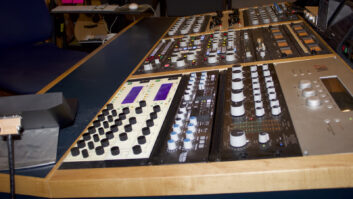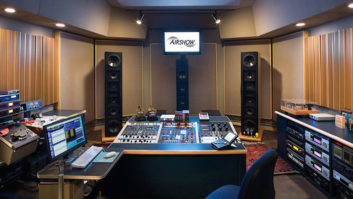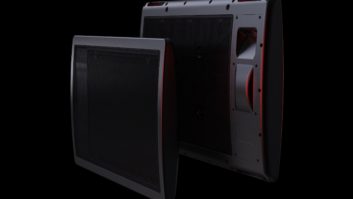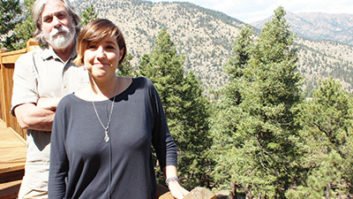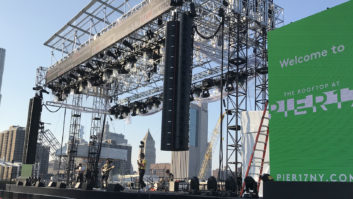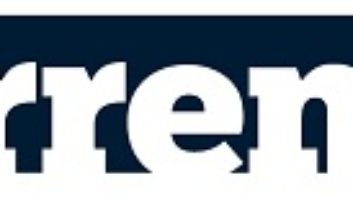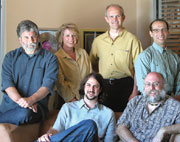

You’ve probably seen Airshow Mastering in the pages of Mix before. Glamour shots of the company’s freshly designed studios showcase cutting-edge gear and the elegant, state-of-the-art-surround design work of acoustician Sam Berkow of SIA Acoustics. But the pictures belie a down-to-earth approach to mastering — and to music in general.
Airshow Mastering’s family at their “Home Away From Home Room,” clockwise from left: David Glasser, general manager Ann Blonston, James Tuttle, Dominick Maita, Charlie Pilzer and Matt Sandowski.
The brainchild of engineer David Glasser, Airshow made its debut in 1983 in Springfield, Va. Glasser’s career in audio has been long and varied, including years of live recording and broadcast work for National Public Radio. He began working with Charlie Pilzer — now chief engineer of the Springfield studio — when musician/technician Pilzer focused more on producing and used Glasser’s services to master his clients’ projects. When one of those projects exhausted its budget, Glasser generously taught Pilzer to edit and master his own recordings and made his studio available to Pilzer during off-hours. The two became partners, growing their business.
Together, they earned Grammys for their mastering/restoration of the Smithsonian’s Anthology of American Folk Music (1997). Also in that year, Glasser informed Pilzer that he was planning to move and build a new studio in Boulder, Colo.
“By then, I knew that the studio was more than just me,” Glasser says. “We had a lot of really great loyal clients who came to Airshow in Springfield, whether or not I was there. Some clients followed me to Boulder, but Charlie has his own clients.”
Pilzer was surprised by Glasser’s decision, but he says he soon came to understand. “The big decision at that point was whether to keep the business together or split it up and be two companies. We both realized that, having worked together, it’s really hard to be a one-person shop. There are still a lot of projects that David and I work on together, where part may be done in Colorado and part will be done in Springfield. And a big part of it is I don’t want to be in competition with David. It’s much better for us to work together.”
Glasser built the Boulder facility in part of an existing building, and two years ago doubled the area by leasing an adjacent space. The new rooms were designed by Berkow, and the existing ones were redesigned, resulting in an integrated, state-of-the-art suite of rooms. “The goal,” says Glasser, “was to build a new large mastering room that was designed from the ground up for surround. We also wanted to broaden the services we were offering, so we added two control rooms and a small overdub booth. One of the control rooms is now rented full-time to a local producer, Scott Smith; the other we called the ‘Home Away From Home Room,’ and it’s basically a great-sounding little control room with a 5.1 monitoring system. An engineer or producer can rent it by the day or week and bring in their own stuff.”
Since moving to Boulder, Airshow has been seriously involved with SACD mastering. “Since the introduction of the format, we’ve mastered more than 100 stereo and multichannel SACDs,” Glasser says. “This is an area we’ve worked hard to develop. SACD and surround were the impetus behind building Studio C.”
Glasser fitted himself beautifully into the local music scene. He masters new recordings for local rock acts such as Big Head Todd & The Monsters and Leftover Salmon, and groups that are selling their live shows on the Internet. “We’ve mastered about 120 shows for String Cheese Incident,” he says, “and, recently, they moved from pressed CDs to making shows available for download.”
Airshow also continues its significant work in audio restoration, including the recent Dust to Digital gospel compilation Goodbye Babylon, a six-CD set of recordings from the 1920s through the 1950s featuring performances by Mahalia Jackson, the Louvin Brothers, Hank Williams and more.
Glasser works with a number of other talented engineers: James Tuttle provides location recording services and assists with operations; Matt Sandowski, a local engineer and jazz guitarist who won a Grammy for his audio restoration work; and Dominick Maita, who left New York’s Sterling Sound to join Glasser. “Sam [Berkow] redesigned one of our existing rooms here for Dominick,” Glasser says, “and he just moved all of his equipment in, duplicating the setup he was using at Sterling.”
“What we do is a mix,” Pilzer says. “Probably two-thirds of what I do is new music. I do classical editing. I have a long-term relationship with several local artists. I do rock ‘n’ roll, acoustic music. It’s something new every day.”
Barbara Schultz is a contributing editor to Mix.

Airshow’s David Glasser and Charlie Pilzer recently worked on audio restoration for a set of rare live recordings from Woody Guthrie. To read more about those sessions, click here.
For a partial Airshow Mastering equipment list, click here.
Click here to check out more pics of Airshow’s two facilities.
What does it take to run a successful mastering studio outside of “the big three” markets? Click here to read three perspectives, including that of Airshow’s David Glasser.
